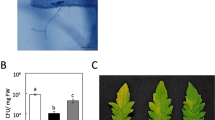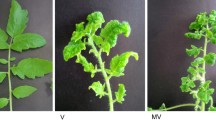Abstract
In addition to the nutrient exchange that is promoted by the arbuscular mycorrhiza symbiosis (AMS) between plants and fungi, AMS triggers mycorrhiza-induced protection against plant pathogens. Although the induction of this protection against diverse plant pathogens has been described for several plant species, it is not clear if its onset differs among genotypes within a species. To address this, we have examined if and how this defense response is triggered by AMS in common bean and tomato. Leaflets from three different genotypes of mycorrhizal common beans and two genotypes of tomato were challenged with the pathogens Sclerotinia sclerotiorum and Xanthomonas campestris pv. vesicatoria, respectively, to determine if disease protection induced by mycorrhiza is genotype-specific. We have found that one tomato and two common bean genotypes display this type of protection, although this was not observed in Az Hig common bean and Micro-Tom tomato. These findings indicate that mycorrhiza-induced disease protection is genotype-specific for the species and genotypes included in this study. Previous work has shown that defense induced by mycorrhiza colonization is effective against foliar pathogens, suggesting the existence of a signal that must move from colonized roots to shoots. We examined the possibility that this defense response can be triggered in scions from non-mycorrhizal plants when they were grafted onto mycorrhizal rootstock. Pathogen infection assays were then performed on leaflets of both scions and rootstock, and infection damage was compared to non-grafted plants. Our results indicate that in genotypes displaying mycorrhiza-induced disease protection, scions originating from non-mycorrhizal plants acquired the ability to decrease disease symptoms when grafted onto mycorrhizal rootstocks, indicating that they are responsive to the putative signal that moves from mycorrhizal roots to the upper part of the plant to trigger disease protection. This grafting experimental system may be useful in elucidating the molecular mechanisms involved in the systemic signaling of mycorrhiza-induced defense response.


Similar content being viewed by others
References
Agrios GN (2005) Plant pathology. Elsevier Academic Press, Florida
Alejo-Iturvide F, Márquez-Lucio M, Morales-Ramírez I, Vázquez-Garcidueñas MS, Olalde-Portugal V (2008) Mycorrhizal protection of chili plants challenged by Phytophthora capsici. Eur J Plant Pathol 120:13–20
Cameron DD, Neal AL, van Wees SCM, Tonemail J (2013) Mycorrhiza-induced resistance: more than the sum of its parts? Trends Plant Sci 18:539–545
Campos-Soriano L, García-Martínez J, Segundo BS (2012) The arbuscular mycorrhizal symbiosis promotes the systemic induction of regulatory defence-related genes in rice leaves and confers resistance to pathogen infection. Mol Plant Pathol 13:579–592
Chabot S, Becard G, Piche Y (1992) Life cycle of Glomus intraradix in root organ culture. Mycology 84:315–321
Cordier C, Pozo MJ, Barea JM, Gianinazzi S, Gianinazzi-Pearson V (1998) Cell defense responses associated with localized and systemic resistance to Phytophthora parasitica induced in tomato by an arbuscular mycorrhizal fungus. Mol Plant-Microbe Interact 11(10):1017–1028
De Deyn G, Biere A, van der Putten W, Wagenaar R, Klironomos JN (2009) Chemical defense, mycorrhizal colonization and growth responses in Plantago lanceolata L. Oecologia 160:433–442
Elsen A, Declerck S, De Waele D (2003) Use of root organ cultures to investigate the interaction between Glomus intraradices and Pratylenchus coffeae. Appl Environ Microbiol 69:4308–4311
Elsen A, Gervacio D, Swennen R, De Waele D (2008) AMF-induced biocontrol against plant parasitic nematodes in Musa sp.: a systemic effect. Mycorrhiza 18:251–256
Fritz M, Jakobsen I, Lyngkjaer MF, Thordal-Christensen H, Pons-Kuhnemann J (2006) Arbuscular mycorrhiza reduces susceptibility of tomato to Alternaria solani. Mycorrhiza 16:413–419
Gianinazzi-Pearson V, Gianinazzi S (1992) Influence of intergenic grafts between host and non-host legumes on the formation of vesicular-arbuscular mycorrhiza. New Phytol 120:505–508
Giovannetti M, Mosse B (1980) An evaluation of techniques for measuring vesicular–arbuscular Mycorrhizal infection in roots. New Phytol 84:489–500
Hao Z, Fayolle L, van Tuinen D, Chatagnier O, Li X, Gianinazzi S, Gianinazzi-Pearson V (2012) Local and systemic mycorrhiza-induced protection against the ectoparasitic nematode **phinema index involves priming of defence gene responses in grapevine. J Exp Bot 63:3657–3672
Harada T (2010) Grafting and RNA transport via phloem tissue in horticultural plants. Sci Hortic 125:545–550
Herrera-Medina MJ, Steinkellner S, Vierheilig H, Ocampo Bote JA, Garcia Garrido JM (2007) Abscisic acid determines arbuscule development and functionality in the tomato arbuscular mycorrhiza. New Phytol 175:554–564
Hoagland DR, Arnon DI (1950) The water-culture method for growing plants without soil. Calif Agric Exp Sta Circ 347:1–32
Hol WHG, Cook R (2005) An overview of arbuscular mycorrhizal fungi–nematode interactions. Basic Appl Ecol 6:489–503
Jung SC, Martinez-Medina A, Lopez-Raez JA, Pozo MJ (2012) Mycorrhiza-induced resistance and priming of plant defenses. J Chem Ecol 38:651–664
Khaosaad T, García-Garrido JM, Steinkellner S, Vierheilig H (2007) Take-all disease is systemically reduced in roots of mycorrhizal barley plants. Soil Biol Biochem 39:727–734
King SR, Davis AR, Liu W, Levi A (2008) Grafting for disease resistance. Hortscience 43:1673–1676
Leyns F, Cleene M, Swings J-G, Ley J (1984) The host range of the genus Xanthomonas. Bot Rev 50:308–356
Li HY, Yang GD, Shu HR, Yang YT, Ye BX, Nishida I, Zheng CC (2006) Colonization by the Arbuscular Mycorrhizal Fungus Glomus versiforme induces a defense response against the root-knot nematode Meloidogyne incognita in the grapevine (Vitis amurensis Rupr.), which includes transcriptional activation of the Class III Chitinase gene VCH3. Plant Cell Physiol 47:154–163
Lingua G, D'Agostino G, Massa N, Antosiano M, Berta G (2002) Mycorrhiza-induced differential response to a yellows disease in tomato. Mycorrhiza 12:191–198
Little TM, Hills FJ (1973) Agricultural experimentation and analysis. Wiley, New York
Liu J, Maldonado-Mendoza I, Lopez-Meyer M, Cheung F, Town CD, Harrison MJ (2007) Arbuscular mycorrhizal symbiosis is accompanied by local and systemic alterations in gene expression and an increase in disease resistance in the shoots. Plant J 50:529–544
Lucas WJ, Yoo BC, Kragler F (2001) RNA as a long-distance information macromolecule in plants. Nat Rev Mol Cell Biol 2:849–857
Marti E, Gisbert C, Bishop GJ, Dixon MS, Garcia-Martinez JL (2006) Genetic and physiological characterization of tomato cv. Micro-Tom. J Exp Bot 57:2037–2047
Mora-Romero GA, Gonzalez-Ortiz MA, Quiroz-Figueroa F, Calderon-Vazquez CL, Medina-Godoy S, Maldonado-Mendoza I, Arroyo-Becerra A, Perez-Torres A, Alatorre-Cobos F, Sanchez F, Lopez-Meyer M (2015) PvLOX2 silencing in common bean roots impairs arbuscular mycorrhiza-induced resistance without affecting symbiosis establishment. Funct Plant Biol 42:18–30
Noval B, Pérez E, Martínez B, León O, Martínez-Gallardo N, Délano-Frier J (2007) Exogenous systemin has a contrasting effect on disease resistance in mycorrhizal tomato (Solanum lycopersicum) plants infected with necrotrophic or hemibiotrophic pathogens. Mycorrhiza 17:449–460
Phillips JM, Hayman DS (1970) Improved procedures for clearing roots and staining parasitic and vesicular-arbuscular mycorrhizal fungi for rapid assessment of infection. Trans Br Mycol Soc 55:158–161
Pozo MJ, Azcon-Aguilar C (2007) Unraveling mycorrhiza-induced resistance. Curr Opin Plant Biol 10:393–398
Pozo MJ, Cordier C, Dumas-Gaudot E, Gianinazzi S, Barea JM, Azcón Aguilar C (2002) Localized versus systemic effect of arbuscular mycorrhizal fungi on defense response to phytophthora infection in tomato plants. J Exp Bot 53:525–534
Pozo MJ, Jung SC, López-Ráez JA, Azcón-Aguilar C (2010) Impact of Arbuscular Mycorrhizal symbiosis on plant response to biotic stress: the role of plant defence mechanisms. In: Koltai H, Kapulnik Y (eds) Arbuscular Mycorrhizas: Physiology and Function. Springer, Netherlands, pp. 193–207
Rosales-Serna R, Acosta-Gallegos JA, Muruaga-Martínez JS, Hernández-Casillas JM, Esquivel-Esquivel G, Pérez-Herrera P (2004) Variedades mejoradas de frijol del Instituto Nacional de Investigaciones Forestales Agrícolas y Pecuarias. Libro Técnico no 6 SAGARPA-INIFAP, Mexico
Schübler A, Schwarzott D, Walker C (2001) A new fungal phylum, the Glomeromycota: phylogeny and evolution. Mycol Res 105:1413–1421
Scott JW, Harbaugh BK (1989) Micro-Tom. A miniature dwarf tomato. Florida Agr Exp Sta Circ S 370:1–6
Shi T, Reeves RH, Gilichinsky DA, Friedmann EI (1997) Characterization of viable bacteria from Siberian permafrost by 16S rDNA sequencing. Microb Ecol 33:169–179
Singh SP, Gutierrez A, Teran H (2003) Registration of indeterminate tall upright small black seeded common bean germplasmb A-55. Crop Sci 43:1887–1888
Smith S, Read D (1997) Mycorrhizal symbiosis, 2 edn. Academic Press, London
St-Arnaud M, Hamel C, Vimard B, Caron M, Fortin JA (1996) Enhanced hyphal growth and spore production of the arbuscular mycorrhizal fungus Glomus intraradices in an in vitro system in the absence of host roots. Mycol Res 100:328–332
Trotta A, Varese GC, Gnavi E, Fusconi A, Sampò S, Berta G (1996) Interactions between the soilborne root pathogen Phytophthora nicotianae var. parasitica and the arbuscular mycorrhizal fungus Glomus mosseae in tomato plants. Plant Soil 185:199–209
Vos C, Claerhout S, Mkandawire R, Panis B, Waele D, Elsen A (2012a) Arbuscular mycorrhizal fungi reduce root-knot nematode penetration through altered root exudation of their host. Plant Soil 354:335–345
Vos C, Geerinckx K, Mkandawire R, Panis B, De Waele D, Elsen A (2012b) Arbuscular mycorrhizal fungi affect both penetration and further life stage development of root-knot nematodes in tomato. Mycorrhiza 22:157–163
Vos C, Van Den Broucke D, Lombi FM, De Waele D, Elsen A (2012c) Mycorrhiza-induced resistance in banana acts on nematode host location and penetration. Soil Biol Biochem 47:60–66
Vos CM, Tesfahun AN, Panis B, De Waele D, Elsen A (2012d) Arbuscular mycorrhizal fungi induce local and systemic resistance in tomato against the sedentary nematode Meloidogyne incognita and the migratory nematode Pratylenchus penetrans. Appl Soil Ecol 61:1–6
Vos C et al. (2013) Mycorrhiza-induced resistance against the root–knot nematode Meloidogyne incognita involves priming of defense gene responses in tomato. Soil Biol Biochem 60:45–54
Whipps JM (2004) Prospects and limitations for mycorrhizas in biocontrol of root pathogens. Can J Bot 82:1198–1227
White TJ, Bruns TD, Lee TD, Taylor JW (1990) Amplification and direct sequencing of fungal ribosomal RNA genes for phylogenetics. In Innis MA, Gelfand DH, Sninsky JJ, White TJ (eds) PCR Protocols: a guide to methods and applications. Academic Press, San Diego, pp. 315–322
Williams B, Kabbage M, Kim H-J, Britt R, Dickman MB (2011) Tip** the balance: Sclerotinia sclerotiorum secreted oxalic acid suppresses host defenses by manipulating the host redox environment. PLoS Pathog 7:e1002107. doi:10.1371/journal.ppat.1002107
Acknowledgments
MLM acknowledges support from the Red de Biotecnología from the Instituto Politécnico Nacional (IPN), the Secretaría de Investigación y Posgrado-IPN (project nos. 20090463 and 20131537), and the Consejo Estatal de Ciencia y Tecnología-Sinaloa grants. MRGA, CGRG and GOMA acknowledge the Consejo Nacional de Ciencia yTecnología of México and the Programa Institucional de Formación de Investigadores (PIFI)-IPN graduate fellowships. GFH acknowledges the Institutional (IPN) and PIFI-IPN graduate fellowships. We thank Brandon Loveall of Improvence for English proofreading of the manuscript.
Conflict of interest
The authors declare no conflicts of interest.
Author information
Authors and Affiliations
Corresponding author
Additional information
G. A. Mora-Romero and R. G. Cervantes-Gámez contributed equally to this work.
R. Salinas Pérez is deceased.
Rights and permissions
About this article
Cite this article
Mora-Romero, G.A., Cervantes-Gámez, R.G., Galindo-Flores, H. et al. Mycorrhiza-induced protection against pathogens is both genotype-specific and graft-transmissible. Symbiosis 66, 55–64 (2015). https://doi.org/10.1007/s13199-015-0334-2
Received:
Accepted:
Published:
Issue Date:
DOI: https://doi.org/10.1007/s13199-015-0334-2




